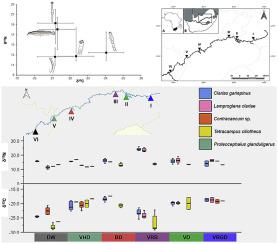International Journal for Parasitology: Parasites and Wildlife ( IF 2.0 ) Pub Date : 2020-05-28 , DOI: 10.1016/j.ijppaw.2020.05.011 Beric M Gilbert 1, 2 , Milen Nachev 3, 4 , Maik A Jochmann 4, 5 , Torsten C Schmidt 4, 5 , Daniel Köster 5 , Bernd Sures 1, 3, 4 , Annemariè Avenant-Oldewage 1

|
Stable isotope analysis offers a unique tool for comparing trophic interactions and food web architecture in ecosystems based on analysis of stable isotope ratios of carbon (13C/12C) and nitrogen (15N/14N) in organisms. Clarias gariepinus were collected from six sites along the Vaal River, South Africa and were assessed for ectoparasites and endoparasites. Lamproglena clariae (Copepoda), Tetracampos ciliotheca and Proteocephalus glanduligerus (Cestoda), and larval Contracaecum sp. (Nematoda) were collected from the gills, intestine and mesenteries, respectively. Signatures of δ13C and δ15N were analysed in host muscle tissue and parasites using bulk stable isotope analysis. Variable stable isotope enrichment between parasites and host were observed; L. clariae and the host shared similar δ15N signatures and endoparasites being depleted in δ13C and δ15N relative to the host. Differences in stable isotope enrichment between parasites could be related to the feeding strategy of each parasite species collected. Geographic and spatial differences in enrichment of stable isotopes observed in hosts were mirrored by parasites. As parasites rely on a single host for meeting their nutritional demands, stable isotope variability in parasites relates to the dietary differences of host organisms and therefore variations in baseline stable isotope signatures of food items consumed by hosts.
中文翻译:

稳定同位素分析揭示了南非瓦尔河系统鱼类宿主 - 寄生虫系统营养结构的空间差异。
稳定同位素分析提供了一种独特的工具,基于对生物体中碳 ( 13 C/ 12 C) 和氮 ( 15 N/ 14 N) 稳定同位素比率的分析,比较生态系统中的营养相互作用和食物网结构。从南非瓦尔河沿岸的六个地点采集了鲶鱼,并对其体外寄生虫和体内寄生虫进行了评估。 Lamprolena clariae (Copepoda)、 Tetracampos ciliotheca和Proteocephalus muduligerus (Cestoda) 以及Contracaecum sp. 幼虫。 (线虫)分别从鳃、肠和肠系膜收集。使用大量稳定同位素分析来分析宿主肌肉组织和寄生虫中的 δ 13 C 和 δ 15 N 特征。观察到寄生虫和宿主之间存在可变的稳定同位素富集; L. clariae和宿主具有相似的 δ 15 N 特征,并且相对于宿主,体内寄生虫的 δ 13 C 和 δ 15 N 被耗尽。寄生虫之间稳定同位素富集的差异可能与收集的每种寄生虫的摄食策略有关。在宿主中观察到的稳定同位素富集的地理和空间差异也反映在寄生虫中。由于寄生虫依赖单一宿主来满足其营养需求,因此寄生虫中的稳定同位素变异性与宿主生物体的饮食差异有关,因此与宿主消耗的食物的基线稳定同位素特征的变化有关。











































 京公网安备 11010802027423号
京公网安备 11010802027423号